Chinese Giant Earth Tiger Tarantula
- March 12, 2024
- 0 comment
The Chinese Gaint Earth Tiger Tarantula, also scientifically known as Haplopelma hainanum, is a captivating arachnid species native to the tropical forests of southern China, particularly the Hainan province. Renowned for its impressive size and striking appearance, this tarantula species boasts a leg span that can reach up to 8 inches, accompanied by a robust body and long, hairy legs. Their abdomens are typically dark-colored, adorned with intricate patterns and markings unique to each individual.

Despite their fearsome appearance, Chinese Earth Tiger Tarantulas are generally docile creatures, preferring to avoid confrontation unless provoked or threatened. They inhabit burrows dug into the earth or seek refuge beneath rocks and debris in their natural habitat. As ambush predators, they rely on stealth and patience to capture their prey, primarily feeding on insects and small invertebrates. While not considered endangered, habitat destruction and illegal pet trade pose significant threats to their population, emphasizing the importance of conservation efforts. Overall, the Chinese Earth Tiger Tarantula is a fascinating species that showcases the beauty and diversity of the natural world, captivating enthusiasts and researchers alike with its unique characteristics and behaviors.
| Specification | Details |
|---|---|
| Scientific Name | Haplopelma hainanum |
| Common Name | Chinese Giant Earth Tiger Tarantula |
| Adult Size | Up to 10 inches (25 centimeters) in leg span |
| Coloration | Dark brown to black |
| Habitat | Tropical forests of China |
| Native Range | Southeastern China, particularly Hainan |
| Temperament | Generally docile, may exhibit aggression |
| Venom | Mildly venomous |
| Diet | Insects, small invertebrates |
| Lifespan | 10 to 15 years in captivity |
| Conservation Status | Not currently endangered |
| Threats | Habitat destruction, illegal pet trade |
| Conservation Efforts | Conservation of natural habitats |
| Suitable as Pets | Requires experienced care and handling |
| Recommended Enclosure Size | At least 10 gallons for adults |
| Substrate | Moistened substrate for burrowing |
| Temperature Range | 75°F to 85°F (24°C to 29°C) |
| Humidity Level | 70% to 80% |
| Feeding Frequency | 2 to 3 times per week |
Everything You Need to Know
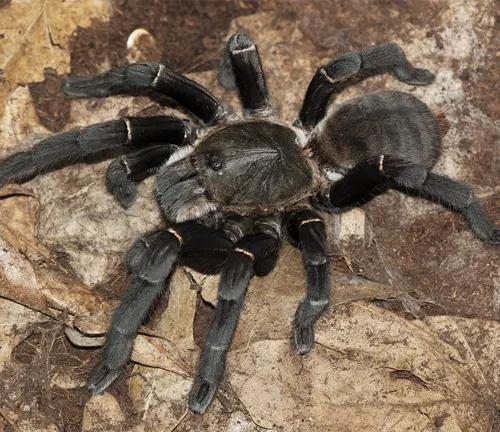
The Chinese Giant Earth Tiger Tarantula, scientifically known as Haplopelma hainanum, is a fascinating arachnid species that has captured the attention of both enthusiasts and researchers alike. Originating from the tropical forests of China, particularly in the Hainan province, this tarantula species exhibits unique characteristics that set it apart from other arachnids.
Appearance and Physical Features
Distinctive Characteristics


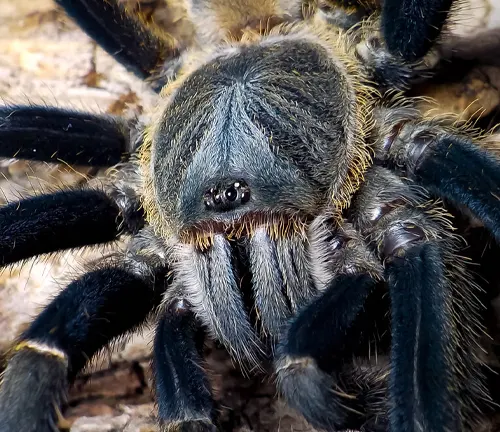
The Chinese Giant Earth Tiger Tarantula boasts several distinctive characteristics that set it apart from other tarantula species. These include:
- Impressive Size: As one of the larger tarantula species, the Chinese Giant Earth Tiger Tarantula can have a leg span of up to 10 inches (25 centimeters) when fully grown, making it a striking presence in any collection.
- Dark Coloration: This tarantula species typically exhibits a dark brown to black coloration, which adds to its imposing appearance. The dark hues of its body and legs provide excellent camouflage in its natural habitat.
- Robust Build: Chinese Giant Earth Tiger Tarantulas have a robust body structure, with a stout abdomen and thick, hairy legs. This sturdy build contributes to their strength and agility as hunters in the wild.
- Intricate Patterns: While primarily dark in color, Chinese Giant Earth Tiger Tarantulas often display intricate patterns and markings on their abdomens. These patterns can vary between individuals and add to the visual appeal of the species.
- Long, Hairy Legs: One of the most striking features of the Chinese Giant Earth Tiger Tarantula is its long, hairy legs. These legs not only aid in locomotion but also serve as sensory organs, helping the tarantula navigate its environment and detect prey.
- Distinctive Venom: While not considered dangerous to humans, the venom of the Chinese Giant Earth Tiger Tarantula is still potent enough to immobilize its prey. This distinctive venom, along with its hunting tactics, contributes to the tarantula’s success as an ambush predator.
Habitat and Natural Environment
Native Habitat
The native habitat of the Chinese Giant Earth Tiger Tarantula encompasses the tropical forests of southeastern China, with a particular focus on regions such as the Hainan province. These forests provide the ideal environment for the tarantula’s survival, characterized by lush vegetation, ample moisture, and a rich diversity of flora and fauna. Within this habitat, the Chinese Giant Earth Tiger Tarantula can be found dwelling in various microhabitats, including burrows dug into the earth and natural crevices formed by rocks and fallen debris. The dense canopy of the forest provides cover and protection for the tarantula, allowing it to thrive in its natural environment. Additionally, the warm and humid climate of the region contributes to the tarantula’s overall well-being, supporting its hunting and reproductive behaviors. Overall, the native habitat of the Chinese Giant Earth Tiger Tarantula plays a crucial role in shaping its ecology and behavior, highlighting the importance of conservation efforts to preserve these unique ecosystems.
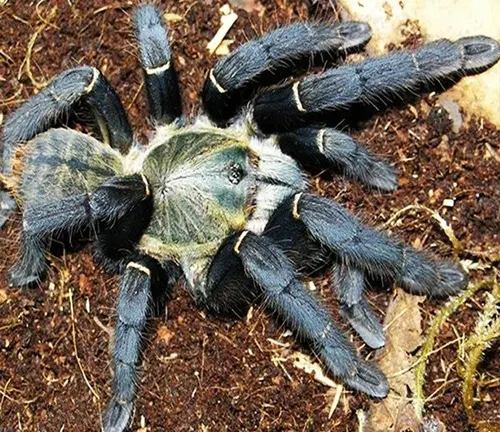
Behavior and Temperament
Hunting and Feeding Habits
Hunting and feeding habits are integral aspects of the Chinese Giant Earth Tiger Tarantula’s behavior. As ambush predators, these tarantulas rely on stealth and patience to capture their prey. They typically wait in concealed locations, such as burrows or hidden spots among vegetation, and use their keen sense of touch to detect vibrations signaling the presence of potential prey.

When prey comes within striking distance, the Chinese Giant Earth Tiger Tarantula pounces swiftly, using its powerful legs to immobilize the victim. Once subdued, the tarantula delivers a venomous bite to incapacitate its prey, allowing it to feed at its leisure.
Chinese Giant Earth Tiger Tarantulas primarily feed on insects and small invertebrates found within their native habitat. Common prey items include crickets, cockroaches, beetles, and other arthropods. Their diet may also include occasional vertebrates, such as small lizards or rodents, although these instances are less frequent.
After capturing their prey, Chinese Giant Earth Tiger Tarantulas use their fangs to inject digestive enzymes, liquefying the internal tissues of the prey. They then consume the liquefied contents, leaving behind the exoskeleton or carcass.
Reproduction and Lifecycle
Breeding Behavior
Breeding behavior is a significant aspect of the Chinese Giant Earth Tiger Tarantula’s lifecycle, playing a crucial role in the continuation of the species. Breeding typically occurs during specific times of the year, often triggered by environmental factors such as changes in temperature and humidity.
Male Chinese Giant Earth Tiger Tarantulas actively seek out females for mating, embarking on a quest to locate potential mates. Once a male identifies a receptive female, he initiates a courtship ritual to demonstrate his suitability as a mate. This courtship display often involves intricate movements, vibrations, and tactile interactions to communicate his intentions and assess the female’s receptivity.

If the female accepts the male’s advances, mating occurs, with the male transferring sperm to the female using specialized structures called pedipalps. After mating, the male may quickly retreat to avoid becoming prey to the female, who may exhibit cannibalistic tendencies, particularly in the wild.
Following successful mating, the female Chinese Giant Earth Tiger Tarantula will prepare to lay her eggs. She constructs a silk-lined egg sac, which she fills with fertilized eggs before sealing it shut to protect the developing embryos. The female diligently guards the egg sac, ensuring its safety and stability until the eggs hatch.
Once the eggs hatch, the female may assist the spiderlings in emerging from the egg sac, using her fangs to tear open the silk enclosure. The spiderlings then disperse into the surrounding environment, beginning their journey towards adulthood.
Breeding behavior in Chinese Giant Earth Tiger Tarantulas is a fascinating and complex process, characterized by elaborate courtship rituals, mating behaviors, and maternal care. Understanding these behaviors is essential for tarantula enthusiasts and breeders interested in successfully breeding and raising healthy spiderlings.
Conservation Status and Threats
Environmental Concerns
Environmental concerns surrounding the Chinese Giant Earth Tiger Tarantula primarily revolve around habitat destruction and the impact of human activities on their natural ecosystems. As inhabitants of the tropical forests of southeastern China, these tarantulas rely on specific environmental conditions to thrive.
One of the most significant threats to the habitat of the Chinese Giant Earth Tiger Tarantula is deforestation, driven by urbanization, agriculture, and logging activities. Clearing of forests not only reduces the available habitat for the tarantulas but also disrupts the delicate balance of the ecosystem, leading to loss of biodiversity and fragmentation of habitat.

Additionally, pollution and habitat degradation pose significant challenges to the survival of the Chinese Giant Earth Tiger Tarantula and other species within their ecosystem. Contamination of water sources, air pollution, and soil degradation can have detrimental effects on the health and reproductive success of these tarantulas, ultimately impacting their population dynamics.
Furthermore, illegal collection for the pet trade poses a direct threat to the wild populations of Chinese Giant Earth Tiger Tarantulas. Overexploitation of these tarantulas for commercial purposes can lead to population declines and even local extinctions if not regulated effectively.
Keeping Chinese Earth Tiger Tarantulas as Pets
Care Requirements
Proper care requirements are essential for maintaining the health and well-being of Chinese Giant Earth Tiger Tarantulas in captivity. Here are some key considerations:
- Enclosure: Provide a spacious enclosure with ample floor space for the tarantula to move around comfortably. A terrarium with secure lids or a glass aquarium with a tight-fitting screen top is ideal to prevent escapes.
- Substrate: Use a substrate that allows for burrowing, such as coconut fiber or peat moss. Maintain a substrate depth of at least a few inches to accommodate natural behaviors.
- Temperature and Humidity: Maintain temperatures between 75°F to 85°F (24°C to 29°C) during the day, with a slight drop at night. Humidity levels should be kept between 70% to 80%, which can be achieved by misting the enclosure regularly or providing a shallow water dish.
- Hiding Places: Offer hiding spots such as cork bark, half logs, or artificial plants to provide security and reduce stress. These hiding places also mimic natural habitat features.
- Feeding: Feed Chinese Giant Earth Tiger Tarantulas a varied diet of live insects such as crickets, mealworms, and roaches. Offer appropriately sized prey items 2 to 3 times per week, adjusting the frequency based on the tarantula’s appetite and size.
- Water: Provide a shallow water dish filled with clean, dechlorinated water. Ensure the dish is shallow enough to prevent drowning but large enough for the tarantula to drink from.
- Handling: Limit handling to a minimum and only when necessary, as tarantulas are delicate creatures and can become stressed or injured easily. If handling is required, do so gently and with caution, avoiding sudden movements.
- Health Monitoring: Regularly monitor the tarantula for signs of illness or injury, such as lethargy, loss of appetite, or abnormal behavior. Seek veterinary care from a qualified exotic animal veterinarian if any health concerns arise.
Different Species
Haplopelma albostriatum
This species is known for its distinctive white-striped legs, contrasting against its dark brown or black body. It inhabits the tropical forests of southeastern China.
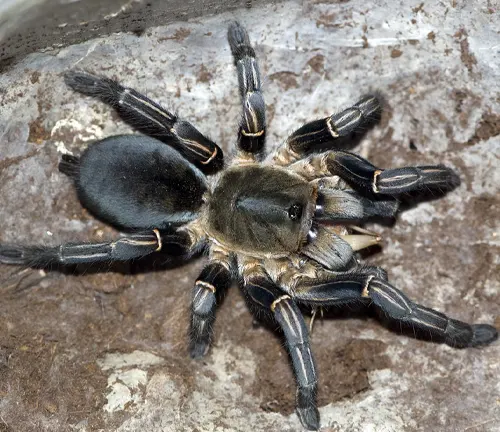
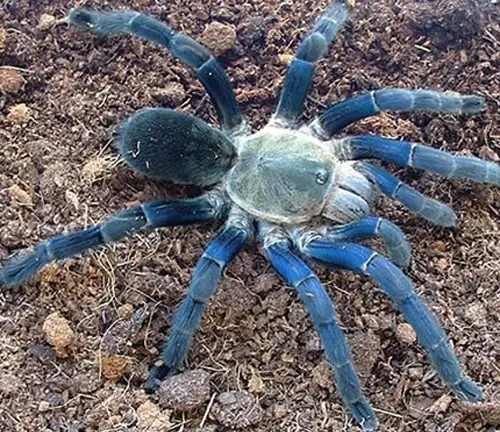
Haplopelma lividum
Commonly referred to as the Cobalt Blue Tarantula, this species showcases vibrant blue coloration on its legs and abdomen. It is native to the forests of Myanmar, Thailand, and Laos, in addition to parts of China.
Haplopelma minax
Also known as the Thai Tiger Tarantula, this species features bold black stripes on its legs, resembling the markings of a tiger. It is found in the dense forests of Thailand, Myanmar, and Vietnam, as well as southern China.
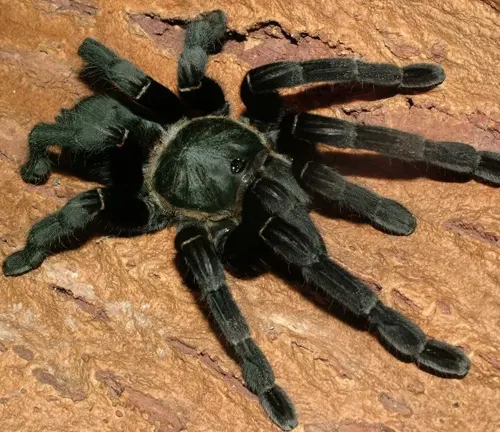

Haplopelma schmidti
This species is recognized for its striking black coloration and impressive size, with a leg span reaching up to 9 inches. It resides in the forests of southern China, particularly in the Yunnan province.
Haplopelma vonwirthi
With its dark brown body and distinctive red hairs on its legs, this species stands out among its counterparts. It is native to the forests of northern Vietnam and southern China.
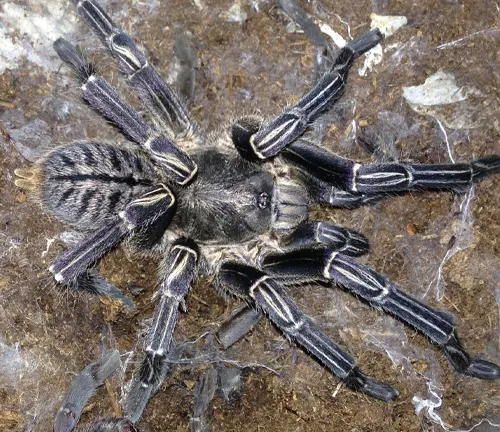
Frequently Asked Questions (FAQs)
- Are Chinese Giant Earth Tiger Tarantulas dangerous to humans?
Chinese Giant Earth Tiger Tarantulas are not considered dangerous to humans, as their venom is relatively mild. However, their bites can cause discomfort and irritation, particularly to those with allergies or sensitivities. - What is the size of a Chinese Giant Earth Tiger Tarantula?
Chinese Giant Earth Tiger Tarantulas can have a leg span of up to 10 inches (25 centimeters) when fully grown, making them one of the larger tarantula species. - How often should Chinese Giant Earth Tiger Tarantulas be fed?
In captivity, Chinese Giant Earth Tiger Tarantulas should be fed 2 to 3 times per week, depending on their size and appetite. It’s essential to offer a varied diet of live insects and invertebrates to ensure their nutritional needs are met. - Do Chinese Giant Earth Tiger Tarantulas require special habitat conditions?
Yes, Chinese Giant Earth Tiger Tarantulas require specific habitat conditions to thrive in captivity. This includes a spacious enclosure with ample substrate for burrowing, as well as appropriate temperature and humidity levels. - Can Chinese Giant Earth Tiger Tarantulas be handled?
While Chinese Giant Earth Tiger Tarantulas are generally docile, handling should be limited to experienced individuals who understand their behavior and can do so safely. It’s essential to approach them with caution and respect their boundaries. - How can I tell the gender of a Chinese Giant Earth Tiger Tarantula?
Determining the gender of a Chinese Giant Earth Tiger Tarantula typically requires expertise or professional assistance. Males often have smaller bodies and longer, thinner legs compared to females. - Do Chinese Giant Earth Tiger Tarantulas molt?
Yes, like other tarantula species, Chinese Giant Earth Tiger Tarantulas molt periodically to grow and regenerate lost limbs. During molting, they may appear inactive and vulnerable, so it’s essential to provide a quiet and undisturbed environment. - What is the temperament of Chinese Giant Earth Tiger Tarantulas?
Chinese Giant Earth Tiger Tarantulas are generally docile in nature, preferring to avoid confrontation unless provoked. However, they may exhibit defensive behavior if they feel threatened or cornered. - Are there any specific health concerns for Chinese Giant Earth Tiger Tarantulas?
While Chinese Giant Earth Tiger Tarantulas are relatively hardy, they can be susceptible to health issues such as dehydration, parasites, and infections. Regular monitoring of their behavior and appearance is essential to detect any potential issues early. - Do Chinese Giant Earth Tiger Tarantulas require a water dish?
Yes, providing a shallow water dish is essential for Chinese Giant Earth Tiger Tarantulas to maintain proper hydration levels. The dish should be cleaned regularly to prevent contamination and ensure the tarantula’s health. - Can Chinese Giant Earth Tiger Tarantulas live together in the same enclosure?
It is generally not recommended to keep multiple Chinese Giant Earth Tiger Tarantulas together in the same enclosure, as they may exhibit territorial behavior and aggression towards each other. Keeping them separately helps prevent potential conflicts and ensures their well-being.














Leave your comment